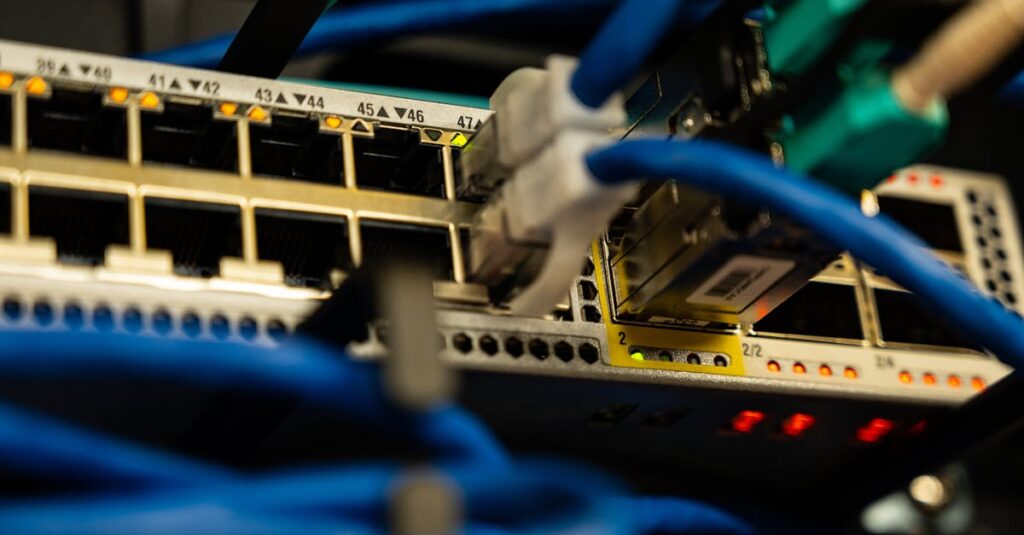In a world where tangled cables can turn even the most organized workspace into a chaotic jungle, network cable management becomes the unsung hero of productivity. Imagine walking into an office where cables are neatly tucked away, like well-behaved puppies on a leash, instead of resembling a scene from a horror movie. Proper cable management not only enhances aesthetics but also boosts efficiency and safety, keeping your tech-savvy environment as smooth as a well-oiled machine.
Let’s face it: nobody wants to play hide-and-seek with a rogue Ethernet cable while trying to troubleshoot a network issue. With a few simple strategies, anyone can transform their cable chaos into a masterpiece of order. So grab your zip ties and cable trays, and get ready to take control of your cords—because a little organization goes a long way in keeping your tech life stress-free and your workspace looking sharp.
Table of Contents
ToggleUnderstanding Network Cable Management
Effective network cable management plays a vital role in creating an organized workspace. It not only improves aesthetics but also enhances performance and safety.
Importance of Cable Management
Maintaining a tidy cable environment prevents tangling and damage, which can lead to significant downtime. Efficient cable management reduces the risk of accidents by minimizing tripping hazards. Increased airflow around devices results in better cooling, prolonging equipment lifespan. Enhanced visibility allows for easier troubleshooting, ultimately boosting productivity. Implementing proper cable management strategies cultivates a stress-free environment for both employees and visitors.
Key Components of Cable Management Systems
Several components contribute to effective cable management systems. Cable trays support a clean layout by providing a designated path for cables. Zip ties help bundle cables neatly together, preventing clutter. Cable organizers, such as sleeves and ducts, keep cables hidden and secure. Patch panels offer a centralized point to manage connections, making configurations easier. Labeling tools simplify identification, resulting in more efficient troubleshooting and maintenance efforts. Each of these components plays an essential role in ensuring a well-structured and functional cable management system.
Types of Network Cables
Understanding different types of network cables helps in selecting the right one for specific needs. Both copper and fiber optic cables serve distinct purposes in network infrastructure.
Copper Cables
Copper cables represent the most common choice for networking. Twisted pair cables, such as Cat5e and Cat6, transmit data effectively over short distances. Shielded twisted pair cables reduce interference, enhancing performance in environments with high electromagnetic interference. Coaxial cables offer durability and decent bandwidth for cable television and internet connections. Effective in various setups, copper cables are generally easier to install and more cost-effective than alternatives.
Fiber Optic Cables
Fiber optic cables excel in high-speed data transmission over long distances. Made of glass or plastic fibers, they utilize light signals to convey information, offering better speed and bandwidth than copper. Single-mode fiber cables support longer distances with minimal signal loss, typically used for telecommunications. Multimode fiber cables serve shorter distances well, ideal for data centers and local networks. Installation requires specific tools and expertise, making fiber optic cables a significant investment but a reliable solution for modern networking needs.
Best Practices for Network Cable Management
Effective network cable management ensures an organized workspace for optimal efficiency. Implementing key strategies leads to enhanced safety and improved performance.
Organizing Cables
Grouping cables is crucial for maintaining organization. Using cable trays helps separate different types of cables, reducing the chance of tangling. Employing zip ties and Velcro straps secures cables neatly, preventing loose ends. Additionally, routing cables along walls or under floors minimizes clutter. Professional installations often allow for easy access to essential connections, improving maintenance and troubleshooting.
Labeling Techniques
Labeling cables simplifies identification and reduces confusion. Adhesive labels can be placed on both ends of each cable, clearly indicating their purpose. Using color-coded labels adds another layer of organization, making it easy to differentiate between cables at a glance. Permanent markers can also help, but ensure the label remains legible over time. In professional settings, creating a cable map supports quick identification, assisting in maintenance or troubleshooting.
Tools and Accessories
Investing in efficient tools enhances cable management processes. Cable organizers provide dedicated spaces for each cable type, preventing tangling. Cable management sleeves can bundle multiple cables together, creating a tidy appearance. Patch panels simplify cable connections, allowing for easy reorganization when needed. Choosing high-quality zip ties and clips ensures durability, while labeled storage boxes hold extra cables securely.
Challenges in Network Cable Management
Network cable management presents various challenges that affect efficiency and safety. Proper organization minimizes disruptions, while poor management leads to clutter and potential hazards.
Common Issues
Tangled cables create confusion and frustration, making troubleshooting complicated. Unlabeled cables complicate identification, causing delays during maintenance. Excessive cable lengths contribute to clutter, making it hard to maintain an organized workspace. Damaged cables often go unnoticed in a chaotic environment, risking connectivity issues. Inefficient airflow can heat up equipment, leading to performance degradation.
Solutions and Tips
Using cable trays helps organize cables and improve airflow around equipment. Securing cables with zip ties or Velcro straps keeps them neatly in place. Labeling cables with clear, color-coded tags simplifies identification and reduces errors. Routinely checking for damage ensures that issues are addressed before they affect performance. Grouping similar cables together facilitates easier troubleshooting and maintenance, creating a more efficient workspace.
Innovations in Cable Management Technology
Innovations in cable management technology enhance organization and efficiency in networking environments. Emerging solutions revolutionize how individuals manage their cables.
Smart Solutions
Smart solutions streamline cable management through advanced technologies. Intelligent cable management systems monitor cable health, tracking performance and signal quality. These systems often include automated alerts for potential issues, reducing downtime. Wireless cable management solutions eliminate the need for complex setups, enabling simple installation and reducing clutter. Additionally, integrated sensors help in identifying and troubleshooting connectivity problems quickly and effectively. This proactive approach ensures optimal network performance while simplifying maintenance procedures.
Future Trends
Future trends in cable management technology focus on sustainability and energy efficiency. Eco-friendly materials for cable management accessories gain popularity, promoting reduced environmental impact. Modular design options allow users to customize setups easily, expanding or changing configurations based on evolving needs. Artificial intelligence is expected to play a significant role, optimizing cable routing and organization based on real-time data analytics. Furthermore, enhanced integration with smart building systems offers seamless control over networking environments. These advancements promise to deliver a more efficient and adaptable cable management framework in the coming years.
Conclusion
Effective network cable management is essential for creating an organized and efficient workspace. By implementing simple strategies and utilizing the right tools, individuals can significantly enhance both aesthetics and functionality. A tidy environment not only improves productivity but also ensures safety, preventing potential hazards associated with tangled or damaged cables.
As technology continues to evolve, staying informed about innovative solutions and best practices will further streamline cable management processes. Embracing these advancements can lead to a more adaptable and efficient network infrastructure. Ultimately, investing time in proper cable management pays off in the long run, fostering a stress-free and productive tech environment.




